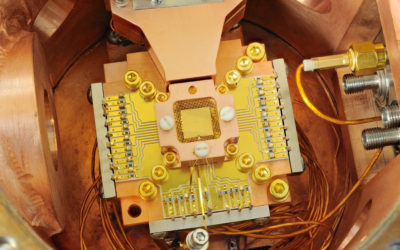“God mode”, for those who aren’t gamers, is a mode of operation (or cheat) built into some types of games based around shooting things. In God mode you are invulnerable to damage and you never run out of ammunition.
From the bookshelf: ‘Chip War’
From the bookshelf: ‘Chip War’
From the bookshelf: ‘Chip War’
The ‘Malacca dilemma’ is generally considered to top China’s list of strategic concerns. The narrow strait linking the Indian and Pacific oceans serves as the conduit for around 60% of China’s oil imports. In a crisis, it would quickly become a chokepoint. Not only is China’s military strategy built around this fact, but so are its huge investments to develop alternative routes for its energy imports.
Chris Miller considers this old-school thinking. According to Miller, an associate professor at the Fletcher School of Law and Diplomacy at Tufts University, these days China’s leaders are more concerned about a blockade ‘measured in bytes rather than barrels’. In Chip War: The Fight for the World’s Most Critical Technology, Miller describes how China is investing massively in its semiconductor industry and pressing foreign companies to turn over sensitive technology in an effort to free itself from America’s stranglehold on its supply of advanced microchips.
Miller reminds us that semiconductors are essential to virtually everything we use, from household appliances, smartphones and vehicles to the most sophisticated satellites and military technology. When car manufacturers around the world were unable in 2021 to meet their targets, temporarily closing many plants, it was because of a shortage of semiconductors, not steel. China currently spends more importing microchips than it does on oil.
Military power in World War II was determined by steel and aluminium, and in the Cold War by nuclear weapons. As Miller sees it, the outcome of the rivalry between the US and China will be determined by semiconductors. Military strategists in both countries know that advanced weaponry requires cutting-edge chips.
And China’s leaders are equally aware that the most advanced chips—and the technology to manufacture them—are produced in supply chains controlled by only five countries: Japan, the Netherlands, South Korea, Taiwan and the United States. Without these countries’ cooperation it will be an uphill struggle for China to develop military technology on a par with the West.
Miller walks the reader through the basics of semiconductor technology, highlighting its long lead-times and complexity. China is now up to a decade behind its competitors, he notes. Meanwhile, Samsung, the Taiwan Semiconductor Manufacturing Company (TSMC) and Silicon Valley have been surging ahead, consistent with Moore’s law of doubling the capacity of semiconductors every year.
In contrast, China’s principal chip manufacturer, the Semiconductor Manufacturing International Corporation, is constrained by the country’s centralised and state-driven policies, which seem unlikely to be loosened anytime soon. Without access to advanced innovations, SMIC will be hard-pressed to catch up.
The strategic significance of microchips has long been underrated. In 2018, as US President Donald Trump was escalating his trade war with China, the question of sanctioning the Chinese telecommunications company ZTE came up. In negotiations to have earlier sanctions lifted, ZTE had provided US officials with false information, aggravating Commerce Secretary Wilbur Ross, who wanted to restrict US firms’ ability to sell to ZTE. The restrictions would have cut off ZTE’s access to American semiconductors, leading to the company’s eventual collapse.
As a traditional ‘trade warrior’, Trump saw the issue as a way of gaining leverage over Chinese leader Xi Jinping. When Xi proposed a deal, Trump agreed to help keep ZTE in business. Eventually the firm paid a hefty fine in exchange for regaining access to US suppliers. Trump patted himself on the back for winning a battle in the trade war, but in fact his decision demonstrated just how poorly he—and parts of his administration—grasped the significance of the emerging technology war.
The US, under President Joe Biden, has since woken up to the magnitude of the challenge. In October last year, the administration effectively banned trade with China in advanced semiconductor technology, manufacturing equipment and the related human resources. It also prohibited foreign companies from exporting microchips that incorporate US technology. The move is widely seen as being designed to choke China’s semiconductor industry. China has already taken the matter to the World Trade Organization. And these are just the first salvos in what looks set to be a long and acrimonious conflict.
Russia’s war of aggression in Ukraine is a stark reminder of the vital role played by semiconductors. As Russia’s munitions stocks dwindled, its heavy dependence on microchip imports quickly became an Achilles’ heel. Had Russia been able to access more semiconductors, the situation in Ukraine today might look very different.
Miller also reminds us how easily a conflict in Taiwan could disrupt the global chip industry. This would not require a D-Day-style amphibious assault. A partial blockade and a single missile hit on TSMC’s most advanced production facility would be enough to halt supply chains. The cost of the knock-on damage could run to hundreds of billions of dollars, sending shock waves around the globe.
Miller’s book is timely, well researched and written for the generalist. Chip War is essential reading for anyone who would like to understand an issue that will be at the heart of geopolitics for years to come.
Republished from the Australian Strategic Policy Institute under a Creative Commons license in the Commonwealth of Australia. Read the original article.

Robert Wihtol is an adjunct faculty member at the Asian Institute of Management and former Asian Development Bank country director for China and director general for East Asia.
Related Articles
Understanding the building blocks for Australia’s quantum future
Australia is undergoing an exciting period of strategic technology policy review and development. The release of its first National Quantum Strategy this week committed the government to building the world’s first error-corrected quantum computer. This is a strategically important technology that has the potential to improve productivity and supply chain efficiency in diverse industries, lower costs across the economy, help reduce carbon emissions and improve public transportation.
Japan needs stronger deterrence than its new defense strategy signals
Since World War II, Japan had long chosen not to possess long-range strike capabilities that could be used against enemy bases. But the Japanese government changed course in December 2022 when it adopted the new national defense strategy (NDS), which included a commitment to acquiring a so-called counterstrike capability. But in order for this new strategy to contribute to deterrence and alter the nation’s defensive role as the ‘shield’ in its alliance with the United States, Tokyo needs to go further than what the NDS outlines.



